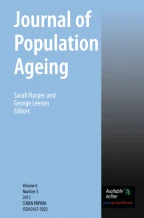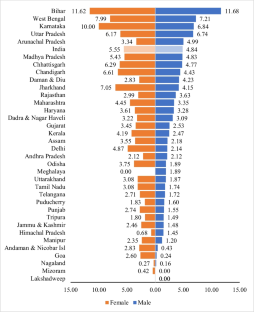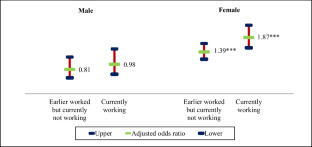Understanding Elder Abuse in India: Contributing Factors and Policy Suggestions

Elder abuse is a multifaceted public health issue. The aim of this study is to provide a concise overview of elder abuse among adults age 60 and above, at the national and state levels in India. The main objective of this research is to examine the prevalence and determinants of elder abuse in light of the latest available data, with an emphasis on working status of older adults. Further, we explore the relative importance of distinctive factors explaining the gendered differential in elder abuse. This study also suggests some strategies to address the problem of elder abuse. Data from the 2020 Longitudinal Ageing Study in India indicates that although the overall prevalence of elder abuse is relatively low in India (5.22%), wide state-level variations prevail. Women, working older adults (especially working women), those under the age of 70, those with greater household assets, those not in a marital union, those staying in rural areas, and those in poor health have significantly higher chances of abuse than their counterparts. Both wealth and education must reach a critical level to curb abuse. Differences in economic factors explain only 10% of the gender gap in elder abuse prevalence. Sociodemographic factors alone account for around 29%, and health-related factors contribute to 28% of the gender differential in elder abuse. We argue for widespread protective policies and targeted program interventions to address elder abuse in India.
This is a preview of subscription content, log in via an institution to check access.
Access this article
Subscribe and save
Springer+ Basic
€32.70 /Month
- Get 10 units per month
- Download Article/Chapter or eBook
- 1 Unit = 1 Article or 1 Chapter
- Cancel anytime
Buy Now
Price includes VAT (France)
Instant access to the full article PDF.
Rent this article via DeepDyve


Similar content being viewed by others

Elder Abuse in Maharashtra: Extent, Forms, and Policy and Programmatic Implications
Chapter © 2018

Elder Abuse and the Human Rights Approach—Insights and Experiences from Finland
Chapter © 2020

Perspectives on Elder Abuse and Mistreatment from Selected Countries and Regions: A Preamble
Chapter © 2020
Explore related subjects
Data Availability
The data used in this study is freely available and easily accessible for researchers through IIPS LASI Study (https://www.iipsindia.ac.in/lasi/).
Notes
Social learning theory posits that violence is a learned behavior that may be passed down intergenerationally. Social exchange theory explains that elder abuse may occur because of the victim’s dependence on the abuse and vice versa. Feminist theory argues that elder abuse is the product of patriarchal family. structure. Examining the psychopathology of the caregiver theory would include looking at how an abuser’s behavioral characteristics contribute to elder abuse. For instance, caregivers who consume alcohol and experience depression and anxiety are more likely to use physical and verbal abuse against an elder. Symbolic interactionism assumes that people view and react to elements or situations according to the subjective meanings they attach to those elements. Everyone attaches their own meaning to every other object, and this meaning is created or modified through social interactions involving symbolic communication with other people. Hence, the perception and interpretation of an object is not always the same for all people.
Tier I cities have a population of 100,000 or more, and Tier II cities have a population from 50,000 to 99,999.
References
- Agewell Foundation. (2014). Human rights of older people in India: A reality check. Agewell Foundation.
- Agewell Foundation. (2018). Annual report 2018–2019. Agewell Foundation.
- Baker, A. A. (1975). Granny battering. International Journal of Family Psychiatry,2(3–4), 369–378. Google Scholar
- Centers for Disease Control and Prevention. (2020). Violence prevention. https://www.cdc.gov/violenceprevention/elderabuse/riskprotectivefactors.html. Accessed 13 Jan 2022
- Chattopadhyay, A., Khan, J., Bloom, D. E., Sinha, D., Nayak, I., Gupta, S., Lee, J., & Perianayagam, A. (2022). Insights into labor force participation among older adults: Evidence from the Longitudinal Ageing Study in India. Journal of Population Ageing,15, 39–59. https://doi.org/10.1007/s12062-022-09357-7ArticleGoogle Scholar
- Chokkanathan, S., & Lee, A. E. Y. (2008). Elder mistreatment in urban India: A community based study. Journal of Elder Abuse & Neglect,17(2), 45–61. https://doi.org/10.1300/J084v17n02_03ArticleGoogle Scholar
- Day, K. (2007). Elder abuse in context of poverty and deprivation and emergency department care. Australasian Emergency Care,10(4), 169–177. https://doi.org/10.1016/j.aenj.2007.08.003ArticleGoogle Scholar
- Dean, A. (2019). Elder abuse: Key issues and emerging evidence. CFCA paper no. 51. Australian Institute of Family Services.
- Dong, X. (2005). Medical implications of elder abuse and neglect. Clinics in Geriatric Medicine,21, 293–313. https://doi.org/10.1016/j.cger.2004.10.006ArticleGoogle Scholar
- Dong, X. Q. (2015). Elder abuse: Systematic review and implications for practice. Journal of the American Geriatrics Society,63(6), 1214–1238. https://doi.org/10.1111/jgs.13454ArticleGoogle Scholar
- Edd, J. A. T., Burnes, D., Elizabeth, A., Dutton, M. A., Mosqueda, L., Lachs, M. S., Pillemer, K., Teresi, J. A., & Burnes, D. (2016). State of the science on prevention of elder abuse and lessons learned from child abuse and domestic violence prevention: Toward a conceptual framework for research. Journal of Elder Abuse & Neglect,28(4–5), 263–300. https://doi.org/10.1080/08946566.2016.1240053ArticleGoogle Scholar
- Evandrou, M., Falkingham, J. C., Qin, M., & Vlachantoni, A. (2017). Elder abuse as a risk factor for psychological distress among older adults in India: A cross-sectional study. BMJ Open, 7(e017152). https://doi.org/10.1136/bmjopen-2017-017152
- Government of India. (1956). The Hindu Adoptions and Maintenance Act, 1956. https://legislative.gov.in/sites/default/files/A1956-78_0.pdf. Accessed 3 Feb 2022
- Government of India. (2020). Schemes and programmes being run by the various ministries/departments of government of India, for welfare of senior citizens. Government of India, Pensioners’ Portal. https://pensionersportal.gov.in/Document/WelfareSchemes.pdf. Accessed 3 Feb 2022
- Hardin, E., & Khan-Hudson, A. (2005). Elder abuse—“society’s dilemma.” Journal of the National Medical Association,97(1), 91–94. Google Scholar
- HelpAge India. (2012). Annual review 2012–13. HelpAge India. https://www.helpageindia.org/pdf/annualreport201213.pdf. Accessed 5 Feb 2022
- HelpAge India. (2014). Main findings: Report on elder abuse in India. HelpAge India. https://www.helpageindia.org/wp-content/uploads/2017/06/highlight-archives.pdf. Accessed 5 Feb 2022
- Hosseinkhani, Z., Khodamoradi, F., & Sheikh, S. (2019). Socioeconomic inequality of elder abuse in Qazvin, Iran. Social Health and Behavior,2(2), 47–51. ArticleGoogle Scholar
- International Institute for Population Science [IIPS]. (2017). National Family Health Survey (NFHS-4), 2015–16: India. International Institute for Population Sciences. http://rchiips.org/nfhs/nfhs-4Reports/India.pdf. Accessed 19 Jan 2022
- International Institute for Population Sciences [IIPS]. (2021). National Family Health Survey (NFHS-5), 2019–21: India report. Mumbai: International Institute for Population Sciences.
- International Institute for Population Sciences [IIPS], National Programme for Health Care of Elderly, Ministry of Health and Family Welfare, Harvard T. H. Chan School of Public Health, and the University of Southern California. (2020). Longitudinal ageing study in India, wave 1, 2017–18, India report. Mumbai: International Institute for Population Sciences. https://www.iipsindia.ac.in/sites/default/files/LASI_India_Report_2020_compressed.pdf. Accessed 19 Jan 2022
- Jackson, S. L. (2009). Understanding elder abuse: A clinician’s guide. American Psychological Association. Google Scholar
- Jackson, S. L., & Hafemeister, T. L. (2016). Theory-based models enhancing the understanding of four types of elder maltreatment. International Review of Victimology,22(3), 289–320. https://doi.org/10.1177/0269758016630887ArticleGoogle Scholar
- Jaggard, P. (2018). Are older adults a burden? Caring for the Ages,19(2), 18. https://doi.org/10.1016/j.carage.2018.01.014ArticleGoogle Scholar
- Jaiprakash, I. (2001). Elder abuse: Global response and Indian initiatives. Indian Journal of Social Work,62(3), 459–463. Google Scholar
- Jamuna, D. (2003). Issues of elder care and elder abuse in the Indian context. Journal of Aging & Social Policy,15(2–3), 125–142. https://doi.org/10.1300/J031v15n02_11ArticleGoogle Scholar
- Johar, M., & Maruyama, S. (2014). Does coresidence improve an elderly parent’s health? Journal of Applied Econometrics,29(6), 965–983. https://doi.org/10.1002/jae.2339ArticleGoogle Scholar
- Khanna, N. (2019). An insight into elderly victimization in India. Journal of Critical Reviews,6(6), 312–314. Google Scholar
- Krug, E. G., Dahlberg, L. L., Mercy, J. A., Zwi, A. B., & Lozano, R., eds. (2002). World report on violence and health. Canadian Journal of Public Health, 93, 451. https://doi.org/10.1007/bf03405037
- Kumar, Y., & Bhargava, A. (2014). Elder abuse in Indian families: Problems and preventive actions. International Journal of Scientific and Research Publications, 4(10), 1–8. http://www.ijsrp.org/research-paper-1014/ijsrp-p3498.pdf. Accessed 12 Feb 2022
- Lieber, J., Clarke, L., Timæus, I. M., Mallinson, P. A. C., & Kinra, S. (2020). Changing family structures and self-rated health of India’s older population (1995–96 to 2014). SSM—Population Health, 11 (August), 1–15. https://doi.org/10.1016/j.ssmph.2020.100572
- Mawar, S., Koul, P., Das, S., & Gupta, S. (2018). Association of physical problems and depression with elder abuse in an urban community of North India. Indian Journal of Community Medicine, 43, 165–169. https://doi.org/10.4103/ijcm.IJCM
- Ministry of Law and Justice. (2007). Maintenance and Welfare of Parents and Senior Citizens Act, 2007. Government of India. https://legislative.gov.in/actsofparliamentfromtheyear/maintenance-and-welfare-parents-and-senior-citizens-act-2007
- Ministry of Social Justice and Empowerment. (1999). National Policy for Older Persons. Government of India. https://socialjustice.gov.in/writereaddata/UploadFile/National%20Policy%20for%20Older%20Persons%20Year%201999.pdf. Accessed 12 Feb 2022
- Momtaz, Y. A., Hamid, T. A., & Ibrahim, R. (2013). Theories and measures of elder abuse. Psychogeriatrics,13, 182–188. https://doi.org/10.1111/psyg.12009ArticleGoogle Scholar
- Nagpaul, K. (1998). Elder abuse among Asian Indians: Traditional versus modern perspectives. Journal of Elder Abuse and Neglect,9(2), 77–92. https://doi.org/10.1300/J084v09n02_07ArticleGoogle Scholar
- National Council on Aging. (2021). Issues for advocates: Get the facts on elder abuse. https://www.ncoa.org/article/get-the-facts-on-elder-abuse. Accessed 22 Apr 2022
- National Health Protection Mission. (2018). Ayushman Bharat. Government of India. https://www.india.gov.in/spotlight/ayushman-bharat-national-health-protection-mission
- National Research Council. (2003). Elder mistreatment: Abuse, neglect, and exploitation in an aging America. National Academies Press.
- Olofsson, N., Lindqvist, K., & Danielsson, I. (2012). Fear of crime and psychological and physical abuse associated with ill health in a Swedish population aged 65–84 years. Public Health,4(126), 358–364. ArticleGoogle Scholar
- Paul, S. (2016). Women’s labour force participation and domestic violence: Evidence from India. Journal of South Asian Development,11(2), 224–250. https://doi.org/10.1177/0973174116649148ArticleGoogle Scholar
- Pillemer, K., Burnes, D., Riffin, C., & Lachs, M. S. (2016). Elder abuse: Global situation, risk factors, and prevention strategies. The Gerontologist,56(52), S194–S205. https://doi.org/10.1093/geront/gnw004ArticleGoogle Scholar
- Press Information Bureau. (2019). The Maintenance and Welfare of Parents and Senior Citizens (Amendment) Bill, 2019. Ministry of Social Justice & Empowerment, Government of India. http://164.100.47.4/BillsTexts/LSBillTexts/asintroduced/374_2019_LS_Eng.pdf
- Ramalingam, A., Sarkar, S., Premarajan, K. C., Rajkumar, R. P., & Subrahmanyam, D. K. (2019). Prevalence and correlates of elder abuse: A cross-sectional, community-based study from rural Puducherry. National Medical Journal of India,32(2), 72–76. https://doi.org/10.4103/0970-258X.275344ArticleGoogle Scholar
- Rashmi, A., Sequeira, L., Kumar, P., & Shashi, R. (2020). Elder abuse in Indian setting–a misconception or a reality–a deductive analysis. Indian Journal of Public Health Research & Development,11(1), 31–34. ArticleGoogle Scholar
- Reddy, B. A. (2014). Labour force participation of elderly in India. International Journal of Social Economics, 43(5), 502–516. https://www.paa2014.princeton.edu/papers/141609. Accessed 15 Jan 2022
- Registrar General of India. (2011). Census of India, 2011: Provisional population tables. Government of India.
- Saikia, A. M., Mahanta, N., Mahanta, A., Deka, A. J., & Kakati, A. (2015). Prevalence and risk factors of abuse among community dwelling elderly of Guwahati City, Assam. Indian Journal of Community Medicine,40(4), 279–281. https://doi.org/10.4103/0970-0218.164406ArticleGoogle Scholar
- Salagre, S., Kundawar, A., Ukarde, A., Mantri, A., Chandak, N., Srivastava, P., Jain, S., Saha, T., & Karandekar, V. (2022). Physicians’ knowledge, attitudes, practices and perceived needs regarding specialised geriatric healthcare: A nation-wide survey in India. Journal of the Association of Physicians of India,70(May), 26–31. Google Scholar
- Samanta, T., Chen, F., & Vanneman, R. (2015). Living arrangements and health of older adults in India. The Gerontologist,70(6), 937–947. https://doi.org/10.1093/geronb/gbu164ArticleGoogle Scholar
- Sathya, T., Nagarajan, R., & Selvamani, Y. (2020). Multimorbidity as a risk factor of elder abuse/mistreatment in India: A cross-sectional study. Journal of Interpersonal Violence, 37(11–12). https://doi.org/10.1177/0886260520980391
- Sathya, T., & Premkumar, R. (2020). Association of functional limitations and disability with elder abuse in India: A cross-sectional study. BMC Geriatrics,20(1), 1–11. https://doi.org/10.1186/s12877-020-01619-3ArticleGoogle Scholar
- Sebastian, D., & Sekher, T. V. (2011). Extent and nature of elder abuse in Indian families: A study in Kerala. HelpAge India Research and Development Journal,17, 20–28. Google Scholar
- Seth, N., Yadav, A., Adichwal, N. K., & Kamble, S. B. (2019). Elder abuse and its association with socio-demographic variables in India. Clinical Epidemiology and Global Health,7(2), 188–191. https://doi.org/10.1016/j.cegh.2018.05.002ArticleGoogle Scholar
- Shohe, S. O., & Srivastav, N. (2018). Work participation among the elderly people living in rural areas in India: A case study on determinants. Indian Journal of Economics and Development,6(11), 1–9. Google Scholar
- Singh, P., & Pattanaik, F. (2020). Unfolding unpaid domestic work in India: Women’s constraints, choices, and career. Palgrave Communications,6(111), 1–13. https://doi.org/10.1057/s41599-020-0488-2ArticleGoogle Scholar
- Sinha, A., & Chattopadhyay, A. (2016). Utilization of maternal and child health care services in North and South India: Does spousal violence matter? International Journal of Population Studies,2(2), 107–122. ArticleGoogle Scholar
- Sinha, A., Chowdhury, B., & Heuvelinec, P. (2022). Physical intimate partner violence in India: How much does childhood socialisation matter? Asian Population Studies, February 11, 1–20.
- Sinha, D., Mishra, P. S., Srivastava, S., & Kumar, P. (2021). Socio-economic inequality in the prevalence of violence against older adults—findings from India. BMC Geriatrics, 21(322)(1), 322. https://doi.org/10.1186/s12877-021-02234-6
- Skirbekk, V., & James, K. S. (2014). Abuse against elderly in India—the role of education. BMC Public Health, 14, 336. https://doi.org/10.1186/1471-2458-14-336
- Tareque, M. I., Islam, T. M., Koshio, A., & Kawahara, K. (2014). Economic well-being and elder abuse in Rajshahi District of Bangladesh. Research on Aging,37(2), 200–224. https://doi.org/10.1177/0164027514527833ArticleGoogle Scholar
- Thennavan, S., Yesuvadian, S., & Ramasamy, N. (2022). Elder abuse/mistreatment and associated covariates in India: Results from the Longitudinal Aging Study in India wave 1, 2017–2018. Epidemiology and Health, 44, e2022017. https://doi.org/10.4178/epih.e2022017
- United Nations. (2020). Policy brief: The impact of COVID-19 on older persons. United Nations Sustainable Development Group. https://unsdg.un.org/sites/default/files/2020-05/Policy-Brief-The-Impact-of-COVID-19-on-Older-Persons.pdf. Accessed 15 Jan 2022
- United Nations Population Fund (UNFPA). (2012). Report on the status of elderly in select states of India, 2011. United Nations Population Fund. https://india.unfpa.org/sites/default/files/pub-pdf/AgeingReport_2012_F.pdf. Accessed 15 Jan 2022
- Verick, S. (2011). Women’s labour force participation in India: Why is it so low? https://www.ilo.org/wcmsp5/groups/public/---asia/---ro-bangkok/---sro-new_delhi/documents/genericdocument/wcms_342357.pdf. Accessed 1 Oct 2022
- World Bank. (2022). ILO STAT database. International Labour Organization. https://data.worldbank.org/indicator/sl.tlf.cact.fe.zs?locations=IN. Accessed 1 Oct 2022
- World Health Organization. (2002). Missing voices: Views of older persons on elder abuse. World Health Organization. Google Scholar
- Yan, E. C., & Tang, C. S. (2004). Elder abuse by caregivers: A study of prevalence and risk factors in Hong Kong Chinese families. Journal of Family Violence,19(5), 269–277. https://doi.org/10.1023/B:JOFV.0000042077.95692.71ArticleGoogle Scholar
- Yon, Y., Mikton, C. R., Gassoumis, Z. D., & Wilber, K. H. (2017). Elder abuse prevalence in community settings: A systematic review and meta-analysis. Lancet Global Health,5(2), e147–e156. https://doi.org/10.1016/S2214-109X(17)30006-2ArticleGoogle Scholar
Acknowledgements
The authors are grateful to the International Institute for Population Sciences (IIPS), Harvard T. H. Chan School of Public Health (HSPH), and the University of Southern California (USC) for providing access to the data for this research. The data themselves are available for public access through IIPS LASI Study (https://www.iipsindia.ac.in/lasi/). The authors also acknowledge Ministry of Health and Family Welfare (MoHFW), National Institute on Aging (NIA/NIH), USA, and United Nations Population Fund, India, for financially supporting the survey. We would also like to thank Todd Manza for extensive copyediting support. We are grateful to IIPS, Mumbai for providing access to the published research papers. Further, we show our gratitude to the Editorial board of the journal and the reviewers as their comments improved the paper significantly.
Author information
Authors and Affiliations
- Department of Population and Development, International Institute for Population Sciences, Mumbai, Maharashtra, India Priya Maurya & Aparajita Chattopadhyay
- College of Social Work, The Ohio State University, Columbus, OH, USA Smitha Rao
- Department of Family and Generations, International Institute for Population Sciences, Mumbai, Maharashtra, India Palak Sharma
- Priya Maurya



